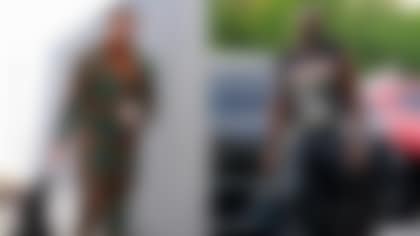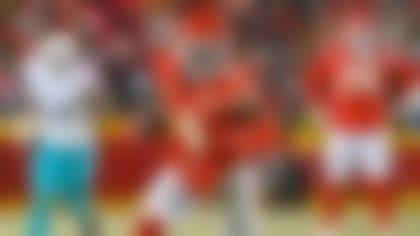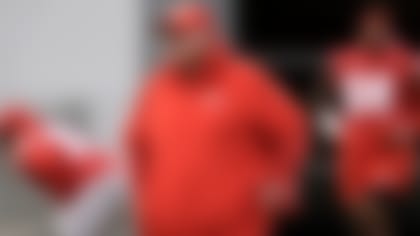This is a look at those who came through at the key moments on the game's grandest stage. We count down the most clutch moments in Super Bowl history, revealing 10 epic moments each week during the playoffs until unveiling the greatest moment the week before the big game.
30. Brooks provides 'the dagger'
Game:Super Bowl XXXVII: Tampa Bay Buccaneers 48, Oakland Raiders 21
Date: Jan. 26, 2003
Location: Qualcomm Stadium, San Diego
The Buccaneers' stingy defense dominated a Raiders team that featured that season's league MVP in quarterback Rich Gannon and the top-rated offense in 2002 (in terms of yards per game). Brooks' pick six provided the climactic moment. Up 34-21 in the fourth quarter, Brooks dropped back into pass coverage from his middle linebacker spot and jumped in front of a Gannon pass, which he returned 44 yards for the game-sealing touchdown.
If you want to get an idea of what this game meant to Jon Gruden, who in the previous offseason was "traded" from the Raiders to the Buccaneers, take a look at his intense reaction to Brooks' pick six play. The Buccaneers' dominant Super Bowl performance also was the culmination of years of rebuilding a franchise that had been known more for being one of the league's less likely to succeed.
29. Hayden slams door on Bears
Game:Super Bowl XLI: Indianapolis Colts 29, Chicago Bears 17
Date: Feb. 4, 2007
Location: Dolphin Stadium, South Florida
After Bears kicker Robbie Gould trimmed the Colts' lead to 22-17, Chicago's defense held Indianapolis to a punt. Taking over at their own 20-yard line with 13:38 left to play, the Bears had seemingly seized momentum. However, four plays into the drive, Bears quarterback Rex Grossman was intercepted by Colts defensive back Kelvin Hayden, who returned the pick 56 yards for the Super Bowl title-clinching score.
This Super Bowl victory ended years of playoff frustrations for the Colts, who were among the league's elite teams but couldn't quite make that step toward ultimate glory.
28. Not quite Griese enough
Game:Super Bowl VI: Dallas Cowboys 24, Miami Dolphins 3
Date: Jan. 16, 1972
Location: Tulane Stadium, New Orleans, La.
Pro Football Hall of Famer Bob Lilly was the first draft pick in Cowboys history, taken with the No. 13 overall selection in the 1961 NFL Draft. It took 11 years for Lilly and the Cowboys to rise from an 0-11-1 outfit in 1960 into NFL champions. The five years prior to Super Bowl victory, the Cowboys only experienced playoff frustration. Dallas lost to Vince Lombardi's Green Bay Packers in consecutive NFL title games -- including the famed Ice Bowl -- and then lost to the Baltimore Colts in a sloppy Super Bowl V.
Following the 1971 season, the Cowboys finally shed that "next year's champions" label, and thanks in large part to the efforts of Lilly and the "Doomsday Defense". With the Cowboys up 3-0 and the Dolphins facing a third-and-9 situation, Lilly chased down the Dolphins' Pro Football Hall of Fame quarterback Bob Griese for a 29-yard loss. This play still stands as the longest negative play from scrimmage in Super Bowl history.
27. Brown to downtown
Game:Super Bowl XI: Oakland Raiders 32, Minnesota Vikings 14
Date: Jan. 9, 1977
Location: Rose Bowl, Pasadena, Calif.
Raiders defensive back Willie Brown's pick six of a pass from Vikings quarterback Fran Tarkenton is one of the signature NFL Films moments. Brown streaked 75 yards down the sideline to put Super Bowl XI out of reach at 32-7, and provide the Raiders -- one of league's dominant teams of that era -- with their first championship.
While this setback pushed the Vikings to a dismal 0-4 record in Super Bowls, this triumph was the first of three Super Bowl wins in eight seasons for the Raiders.
26. Beebe chases down Lett
Game:Super Bowl XXVII: Dallas Cowboys 52, Buffalo Bills 17
Date: Jan. 31, 1993
Location: Rose Bowl, Pasadena, Calif.
The Cowboys kicked off a dynasty in the 1992 season that would earn the franchise "Team of the '90s" designation. However, arguably the most memorable moment from the Cowboys' destruction of the Bills in the Rose Bowl came when the game was already in hand. Cowboys defensive lineman Jim Jeffcoat forced Bills quarterback Frank Reich to fumble -- one of a Super Bowl-record nine turnovers in the game -- and Dallas' Leon Lett scooped up the ball and seemed to be well on his way to a touchdown that would place an emphatic exclamation point on the Cowboys' dump trucking of the Bills. Instead, speedy Bills wide receiver Don Beebe chased down a showboating Lett, and knocked the ball from Lett's grip just before he crossed the goal line. The ball rolled out of bounds for a touchback.
Had Lett scored, it would have given the Cowboys a Super Bowl record for points (topping the 55 scored by the San Francisco 49ers in Super Bowl XXIV). Instead, sports fans were treated to one of the most infamous moments in Super Bowl history. A strong case could also be made that this is the most famous play by a losing side in Super Bowl history.
25. Super Bowl XL-ence
Game:Super Bowl XL: Pittsburgh Steelers 21, Seattle Seahawks 10
Date: Feb. 5, 2006
Location: Ford Field, Detroit
Kelly Herndon's Super Bowl record 76-yard interception return (this record would be broken by James Harrison in Super Bowl XLIII) set up a Seahawks score that trimmed the Steelers' lead to 14-10 and provided Seattle hope in what had been a sloppy game. Shortly after, however, Pittsburgh dug into its bag of tricks and utilized receiver Antwaan Randle El's full complement of skills. Antwaan Randle El -- who played quarterback in college at Indiana -- collected the ball from running back Willie Parker on a reverse and heaved a long pass to receiver Hines Ward for the game-clinching touchdown.
The win gave the Steelers a fifth Super Bowl win, tying the team with the Dallas Cowboys and San Francisco 49ers for most in Super Bowl history (of course, three years later, the Steelers collected a sixth Vince Lombardi Trophy). With the win in Super Bowl XL, the Steelers also became the first No. 6 playoff seed to win a Super Bowl.
24. Brown is scourge of Steelers
Game:Super Bowl XXX: Dallas Cowboys 27, Pittsburgh Steelers 17
Date: Jan. 28, 1996
Location: Sun Devil Stadium, Tempe, Ariz.
Unheralded Larry Brown -- a 12th-round pick of the Cowboys in the 1991 NFL Draft -- earned the distinction of becoming the first cornerback to be named Super Bowl MVP by picking off Steelers quarterback Neil O'Donnell twice in the second half of the Cowboys' third Super Bowl win in four seasons.
Brown's second interception was the game-breaker. O'Donnell hit a wide-open Brown for the pick, which was returned 33 yards to the Steelers' 6-yard line. The play set up Emmitt Smith's 4-yard touchdown run that gave the game its final tally and ended any hope for a Pittsburgh comeback.
23. Rodgers' pinpoint pass puts Pack in position
Game:Super Bowl XLV: Green Bay Packers 31, Pittsburgh Steelers 25
Date: Feb. 6, 2011
Location:Cowboys Stadium, Arlington, Texas
After the Steelers had trimmed the Packers' lead to 28-25, Green Bay faced a third-and-10 situation with six minutes remaining in the game. Packers quarterback Aaron Rodgers fired a pass to receiver Greg Jennings, who caught the ball that was just out of the reach of Steelers defensive back Ike Taylor. The play was monumental. Green Bay was able to take four more minutes off the game clock and added to its lead after a Mason Crosby field goal just before the two-minute warning.
Like the Steelers five years prior, the Packers were a sixth playoff seed to emerge victorious in the Super Bowl and Green Bay has the distinction of being the first NFC team to do so. The Packers collected a league-record 13th NFL championship in Super Bowl XLV, a record that includes four Super Bowl wins.
22. Warner to Bruce for the winner
Game:Super Bowl XXXIV: St. Louis Rams 23, Tennessee Titans 16
Date: Jan. 30, 2000
Location: Georgia Dome, Atlanta
After building a 16-0 lead, the Rams saw that lead evaporate as Tennessee scored 16 unanswered points in the second half, tying up the game at 16-16 with 2:12 left in regulation. This was the largest deficit overcome in a Super Bowl.
Enter Kurt Warner, who emerged in the 1999 season from unknown backup quarterback to league MVP. His storybook season would get an epic final chapter. On the Rams' first offensive play following the Titans' knotting up the game, Warner hit receiver Isaac Bruce for a 73-yard touchdown play that would provide the winning margin. This dramatic moment also set in motion a wild final couple minutes of play that included a great escape from Titans quarterback Steve McNair (see play No. 32 on this list) and Rams linebacker Mike Jones' tackle of Titans receiver Kevin Dyson one yard short of the end zone.
21. McGee becomes a legend
Game:Super Bowl I: Green Bay Packers 35, Kansas City Chiefs 10
Date: Jan. 15, 1967
Location: Los Angeles Memorial Coliseum
There are stories about what happened the night before Super Bowl I. It's true. All of it. Max McGee, the hangover, the first Super Bowl touchdown. They're real.
The Super Bowl turns 50 this year, but its humble beginning as sporting curiosity provided a cult hero for the ages before its inaugural kickoff (though, the fuzzy details wouldn't become public until well after the game). McGee -- who caught just four passes during the 1966 season -- wasn't figuring to hit the field in the First AFL-NFL World Championship Game (it would retroactively officially be known as Super Bowl I years later). So, he took part in the inviting nightlife of Tinseltown the evening before the game and stumbled back into the hotel the morning of the game. Well, it turned out that McGee would be pressed into action when starting receiver Boyd Dowler went down with an injury. McGee then scored the first touchdown in Super Bowl history, snagging a Bart Starr pass with one hand and racing to the end zone for the opening score. Later in the game, McGee added a second touchdown catch, and finished the game with seven receptions for 138 yards.
Follow Jim Reineking on Twitter @jimreineking.











